I can count to 100 by ones and by tens
MATH
K.CC.1 I can count to 100 by ones and by tens.
Race Time
Cut out construction paper racecars and number 1-10. Mix them up and then ask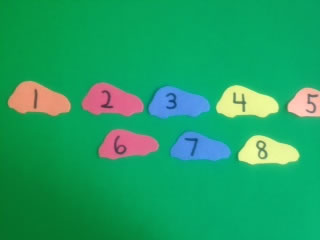 children to put them in order and count. (Write numbers 10-100 on paper cars for children to place in order.)
children to put them in order and count. (Write numbers 10-100 on paper cars for children to place in order.)
*Purchase toy cars at a dollar store and put sticky dots on them. Number 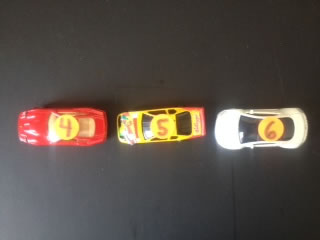 the dots from 1-10 for children to put in order. You could also use the cars for addition, tens and ones, etc.
the dots from 1-10 for children to put in order. You could also use the cars for addition, tens and ones, etc.
Numbers in the News
Give children newspapers and ask them to highlight the numbers 1-10.
•Can they find the numbers 1-10, cut them out, and them glue them in order?
K.CC.3 I can write numbers 0-20. I can match numbers to the amount of things I count.
Long Book
Stack 4 sheets of paper and staple 4 times down the short side. Cut long strips 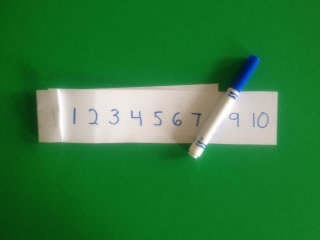 between the staples. Children take the books and write numerals from 1-10 on the first strip, 11-20 on the second strip, and so forth.
between the staples. Children take the books and write numerals from 1-10 on the first strip, 11-20 on the second strip, and so forth.
Count the Room
Make a list of common classroom objects (chairs, boys, girls, teachers, computers,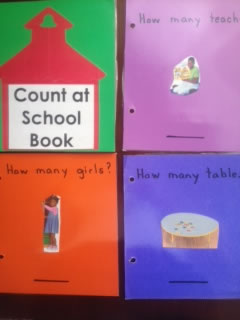 puppets, noses, shoes, monkeys, tigers – you can make this funny and challenging!) Children walk around the room, count the objects, and write their responses on the line.
puppets, noses, shoes, monkeys, tigers – you can make this funny and challenging!) Children walk around the room, count the objects, and write their responses on the line.
K.CC.4 I can understand that a number represents an amount of objects.
Set Book
Stack 5 sheets of paper and staple in all four corners. Cut down the 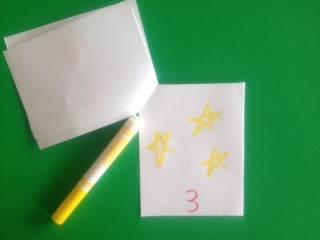 middle lengthwise and widthwise to make four little books. Make these for each child in the classroom. Children write numerals 1-5 on the pages of the book and then make appropriate sets. They can use markers, stamps, stickers, or cut out magazine pictures.
middle lengthwise and widthwise to make four little books. Make these for each child in the classroom. Children write numerals 1-5 on the pages of the book and then make appropriate sets. They can use markers, stamps, stickers, or cut out magazine pictures.
•Make set books with 10 pages or more.
Clip Cards
Write numerals 0-10 on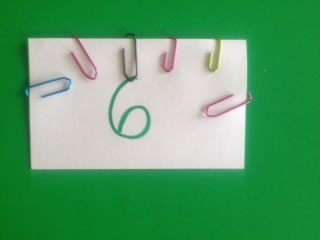 index cards. Children take paper clips and put the appropriate amount on each card.
index cards. Children take paper clips and put the appropriate amount on each card.
Math Concept Maps
Prepare blank math concept maps with 4-8 sections. Children write a numeral in the middle circle and then draw/write different ways to show that number.
Ten Frame Rock and Roll
Children take one or two dice, roll them, and build that amount on their frame.
K.CC.4a I can count objects one by one and tell how many.
Pencil Pocket Book
Take five pencil pockets and make a book with book rings. 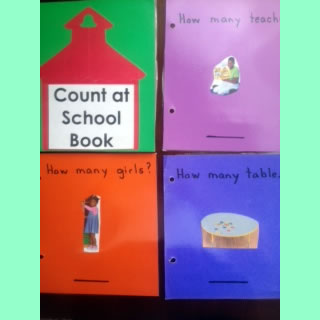 Write numerals on sticky notes and attach to the pockets. Children take small erasers, popsicle sticks, coins, and other flat objects and make appropriate sets in the pockets.
Write numerals on sticky notes and attach to the pockets. Children take small erasers, popsicle sticks, coins, and other flat objects and make appropriate sets in the pockets.
One to One
Children match up pompoms, beans, erasers, pebbles, and other small objects with dots on cards.
K.CC.5 I can count 20 things.
Math Cups
Write numerals 1-20 on plastic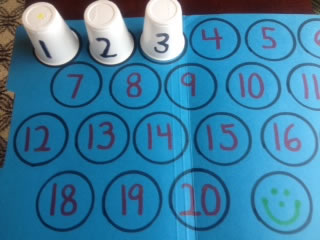 bathroom cups. Trace around the bottom of a cup 20 times on a file folder. Write numerals 1-20 in the circles. Mix up the bathroom cups and then ask children to match them up with the file folder.
bathroom cups. Trace around the bottom of a cup 20 times on a file folder. Write numerals 1-20 in the circles. Mix up the bathroom cups and then ask children to match them up with the file folder.
•Can the children stack up the cups from 1-20?
Calendar Puzzles
You will need 2 copies of a calendar. Cut up one calendar. Mix up the pieces and then have children match up the numbers. Ask them to count the days on the calendar.
Smart Cookies
Write numerals on plastic plates with a permanent marker. Give children play dough and ask them to make the appropriate number of cookies for each plate.
KCC.6 I can tell you if a group has greater than, less than, or the same as another group.
More, Less, Equal
Write “more,” “less,” “equal” on three index cards and place in a bag. Children roll a die and then choose a card and make a set that is more, less, or equal to the amount on the die. You can use counters or play dough for this activity.
cards and place in a bag. Children roll a die and then choose a card and make a set that is more, less, or equal to the amount on the die. You can use counters or play dough for this activity.
K.CC.7 I can compare two written numbers.
Dealer’s Choice
Remove the face cards from a deck 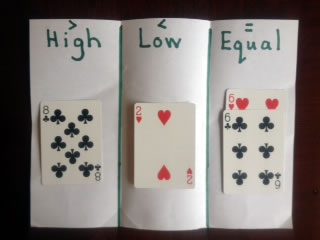 of playing cards. Draw three sections on a sheet of construction paper and write “high,” “low,” and “equal.” Children turn over two cards at a time and place the cards in the appropriate pile.
of playing cards. Draw three sections on a sheet of construction paper and write “high,” “low,” and “equal.” Children turn over two cards at a time and place the cards in the appropriate pile.
*This is a fun game to play with a friend.
K.OA.1 I can add and subtract with my fingers, objects, and pictures.
Hands Up Math
Cut two hands out of construction 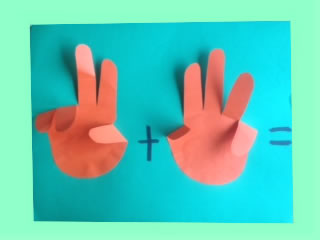 paper. Glue the palms to a sheet of construction paper so the fingers can bend. Children bend down the fingers to demonstrate addition and subtraction.
paper. Glue the palms to a sheet of construction paper so the fingers can bend. Children bend down the fingers to demonstrate addition and subtraction.
Math Mat
You will need a file folder or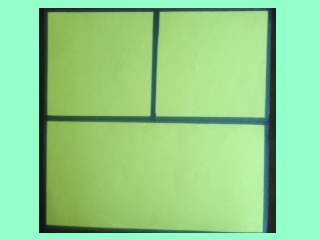 heavy sheet of paper to make a math mat. Fold it in half and trace over the creased line. Draw a line to divide the top section in half. Children use counters to make two sets in the top sections. They bring the objects together in the bottom section to demonstrate addition/joining them together.
heavy sheet of paper to make a math mat. Fold it in half and trace over the creased line. Draw a line to divide the top section in half. Children use counters to make two sets in the top sections. They bring the objects together in the bottom section to demonstrate addition/joining them together.
•Use math mats as a concrete way to demonstrate the missing addend.
•Divided plastic plates with 3 sections can also be used for addition, subtraction, and the missing addend.
K.OA.2 I can add and subtract within ten by drawing or using objects to solve problems.
Ten Frame Rock and Roll
Children take two dice, roll them, build that amount on their frame, and then tell how many altogether.
Play Dough Plus
Write addition and subtraction facts on index cards and place in a bag. Children choose a card and then use play dough to solve the problem.
K.OA.3 I can decompose numbers less than or equal to 10 in different ways.
Math Bags
You will need zip sandwich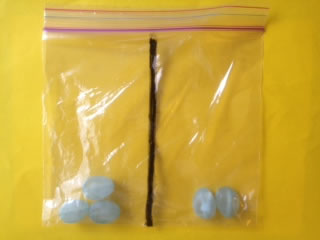 bags and small, flat objects such as buttons or glass pebbles for this activity. Draw a line down the middle of a bag with a permanent marker. Insert objects in the bag. Children slide the items
bags and small, flat objects such as buttons or glass pebbles for this activity. Draw a line down the middle of a bag with a permanent marker. Insert objects in the bag. Children slide the items
from one side to the other to make different combinations. Can they write down the different combinations?
Spill the Beans
You will need an empty tin of  mints and lima beans for this center. Spread lima beans on a newspaper and spray paint one side. Insert six beans with the colored side up in the tin. The children count how many and write it down. Next, they close the lid and shake the beans. How many colored beans? How many white beans? How many in all? They continue to shake the beans and say (or write) down the different combinations.
mints and lima beans for this center. Spread lima beans on a newspaper and spray paint one side. Insert six beans with the colored side up in the tin. The children count how many and write it down. Next, they close the lid and shake the beans. How many colored beans? How many white beans? How many in all? They continue to shake the beans and say (or write) down the different combinations.
K.OA.4 I can add to any number from one to nine to make ten.
Spiders in a Cave
You will need plastic spider rings (or a similar item) and a bowl. Count out ten spiders and turn the bowl upside down to make a “cave” for the spiders. Children take turns hiding spiders in the cave. Friends try and guess how many spiders are in the cave.
(or a similar item) and a bowl. Count out ten spiders and turn the bowl upside down to make a “cave” for the spiders. Children take turns hiding spiders in the cave. Friends try and guess how many spiders are in the cave.
Next Page
 children to put them in order and count. (Write numbers 10-100 on paper cars for children to place in order.)
children to put them in order and count. (Write numbers 10-100 on paper cars for children to place in order.) the dots from 1-10 for children to put in order. You could also use the cars for addition, tens and ones, etc.
the dots from 1-10 for children to put in order. You could also use the cars for addition, tens and ones, etc. between the staples. Children take the books and write numerals from 1-10 on the first strip, 11-20 on the second strip, and so forth.
between the staples. Children take the books and write numerals from 1-10 on the first strip, 11-20 on the second strip, and so forth.  puppets, noses, shoes, monkeys, tigers – you can make this funny and challenging!) Children walk around the room, count the objects, and write their responses on the line.
puppets, noses, shoes, monkeys, tigers – you can make this funny and challenging!) Children walk around the room, count the objects, and write their responses on the line. middle lengthwise and widthwise to make four little books. Make these for each child in the classroom. Children write numerals 1-5 on the pages of the book and then make appropriate sets. They can use markers, stamps, stickers, or cut out magazine pictures.
middle lengthwise and widthwise to make four little books. Make these for each child in the classroom. Children write numerals 1-5 on the pages of the book and then make appropriate sets. They can use markers, stamps, stickers, or cut out magazine pictures. index cards. Children take paper clips and put the appropriate amount on each card.
index cards. Children take paper clips and put the appropriate amount on each card. Write numerals on sticky notes and attach to the pockets. Children take small erasers, popsicle sticks, coins, and other flat objects and make appropriate sets in the pockets.
Write numerals on sticky notes and attach to the pockets. Children take small erasers, popsicle sticks, coins, and other flat objects and make appropriate sets in the pockets. bathroom cups. Trace around the bottom of a cup 20 times on a file folder. Write numerals 1-20 in the circles. Mix up the bathroom cups and then ask children to match them up with the file folder.
bathroom cups. Trace around the bottom of a cup 20 times on a file folder. Write numerals 1-20 in the circles. Mix up the bathroom cups and then ask children to match them up with the file folder.  cards and place in a bag. Children roll a die and then choose a card and make a set that is more, less, or equal to the amount on the die. You can use counters or play dough for this activity.
cards and place in a bag. Children roll a die and then choose a card and make a set that is more, less, or equal to the amount on the die. You can use counters or play dough for this activity. of playing cards. Draw three sections on a sheet of construction paper and write “high,” “low,” and “equal.” Children turn over two cards at a time and place the cards in the appropriate pile.
of playing cards. Draw three sections on a sheet of construction paper and write “high,” “low,” and “equal.” Children turn over two cards at a time and place the cards in the appropriate pile.  paper. Glue the palms to a sheet of construction paper so the fingers can bend. Children bend down the fingers to demonstrate addition and subtraction.
paper. Glue the palms to a sheet of construction paper so the fingers can bend. Children bend down the fingers to demonstrate addition and subtraction. heavy sheet of paper to make a math mat. Fold it in half and trace over the creased line. Draw a line to divide the top section in half. Children use counters to make two sets in the top sections. They bring the objects together in the bottom section to demonstrate addition/joining them together.
heavy sheet of paper to make a math mat. Fold it in half and trace over the creased line. Draw a line to divide the top section in half. Children use counters to make two sets in the top sections. They bring the objects together in the bottom section to demonstrate addition/joining them together. bags and small, flat objects such as buttons or glass pebbles for this activity. Draw a line down the middle of a bag with a permanent marker. Insert objects in the bag. Children slide the items
bags and small, flat objects such as buttons or glass pebbles for this activity. Draw a line down the middle of a bag with a permanent marker. Insert objects in the bag. Children slide the items  mints and lima beans for this center. Spread lima beans on a newspaper and spray paint one side. Insert six beans with the colored side up in the tin. The children count how many and write it down. Next, they close the lid and shake the beans. How many colored beans? How many white beans? How many in all? They continue to shake the beans and say (or write) down the different combinations.
mints and lima beans for this center. Spread lima beans on a newspaper and spray paint one side. Insert six beans with the colored side up in the tin. The children count how many and write it down. Next, they close the lid and shake the beans. How many colored beans? How many white beans? How many in all? They continue to shake the beans and say (or write) down the different combinations. (or a similar item) and a bowl. Count out ten spiders and turn the bowl upside down to make a “cave” for the spiders. Children take turns hiding spiders in the cave. Friends try and guess how many spiders are in the cave.
(or a similar item) and a bowl. Count out ten spiders and turn the bowl upside down to make a “cave” for the spiders. Children take turns hiding spiders in the cave. Friends try and guess how many spiders are in the cave.